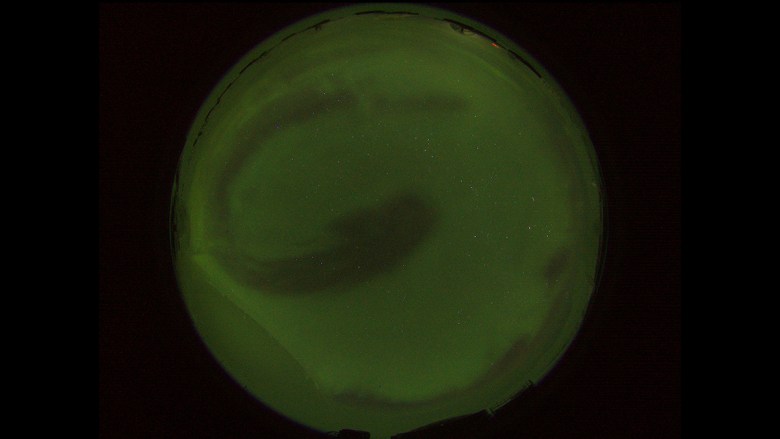
For nearly 28 hours, starting on Christmas night of 2022, a rare type of aurora illuminated the Arctic. A faint, greenish glow known as a polar rain aurora covered thousands of kilometers across the skies. For the first time, this intriguing light show was captured on camera by a group of scientists who had been waiting for more than a decade for the opportunity.
Run-of-the-mill aurorae are caused by the solar wind, a stream of charged particles emanating from the Sun that relentlessly hits our atmosphere. Earth’s magnetic field funnels these particles toward the poles, where they collide with atmospheric gases, primarily oxygen and nitrogen, making them emit light.
Polar rain aurorae, on the other hand, appear only during a prolonged pause in the flow of the solar wind—an unusual occurrence. When chaotic solar winds subside, energetic electrons emanating directly from the Sun’s corona can travel along magnetic field lines and reach Earth’s atmosphere without interference.
In December 2022 such a pause in the solar wind occurred, likely at the boundary between two “gusts” traveling at different speeds. Like ocean waves crashing on a beach, when a faster-moving wave is followed by a slower one, a temporary gap forms between them. The same gap also reached Mars, where it was detected from orbit by NASA’s MAVEN (Mars Atmosphere and Volatile Evolution) spacecraft.
“This is a very special situation.”
“This is a very special situation,” said Keisuke Hosokawa, a space physicist at the University of Electro-Communications in Tokyo who led the team that captured the first ground-based images of the phenomenon. The last time a comparable event happened was in 1999, when a polar rain aurora was detected by satellite.
Hosokawa had been looking forward to this moment for more than a decade, ever since he and his colleagues installed a robotic camera with this specific goal at a dedicated facility on the Norwegian archipelago of Svalbard, very close to the North Pole.
Typical aurorae appear at latitudes between 65° and 70°, whereas polar rain aurorae happen farther north, at 90°—right at the pole. The phenomenon also lacks the usual features of normal aurorae, such as waving streams and pillars of light.
What Hosokawa captured looked “very much different” from typical aurorae, he said. His camera was especially sensitive, but he said the phenomenon was so bright that bystanders in Svalbard could have seen a homogeneous greenish glow covering the entire sky with their naked eyes.
Scientists used sensitive cameras to capture the polar rain aurora. Credit: Keisuke Hosokawa
The researchers matched their observations to ultraviolet images from U.S. military weather satellites, confirming that the greenish glow was, indeed, a polar rain aurora. Hosokawa and his colleagues reported the findings in Science Advances.
Thanks to a fish-eye lens, Hosokawa’s camera showed that the entire visible sky glowed, but that was just a fraction of the aurora’s extent.
The camera also showed the aurora wasn’t completely smooth. It had some embedded structures that looked like greenish glowing patches and occasionally took on the shape of a large mushroomlike feature. The researchers speculated that this could reflect activity on the solar surface itself, with Earth’s atmosphere acting like a screen.
“That’s the key about this type of aurora—it’s not modified by anything between the Sun and the Earth,” said Allison Jaynes, a space and plasma physicist at the University of Iowa who wasn’t involved in the study. “I’m sure people are going to be working on modeling this and trying to understand what all those features are.”
More Than Pretty Lights
Unlike typical aurorae, which tend to appear in both hemispheres simultaneously, polar rain aurorae have been observed only in the Northern Hemisphere. This is likely because the phenomenon requires a direct magnetic connection between the Sun and Earth, and it can’t happen at both poles at the same time, Hosokawa said. It is “surprising,” he added, that the connection seems never to have been observed at the South Pole.
Hosokawa said he thinks that studying these aurorae can help him and other scientists understand these rare instances of a direct magnetic connection between the Sun and Earth. What they learn could be applicable to other planets, such as Mars and Venus.
“Now that we know that it can be detected from the ground, we can actually specifically build imagers that have the right sensitivity.”
The next step for the authors is to check whether the incoming solar electrons had any effect on Earth’s atmosphere. Recent studies suggest aurorae can influence ozone density in the polar regions below the 100-kilometer altitude in which they form, and “I’m guessing that this special aurora can also affect the atmosphere,” Hosokawa said. He and his colleagues are already looking into the ozone concentration in satellite data. “We are hoping to find a connection,” Hosokawa said.
“Now that we know that it can be detected from the ground, we can actually specifically build imagers that have the right sensitivity,” Jaynes said. In the meantime, the data collected by Hosokawa and his colleagues will be looked at in detail for years to come, until the next polar rain aurora comes.
—Javier Barbuzano (@javibarbuzano), Science Writer
Citation: Barbuzano, J. (2024), Scientists captured the first glimpse of a rare polar aurora, Eos, 105, https://doi.org/10.1029/2024EO240347. Published on 8 August 2024.
Text © 2024. The authors. CC BY-NC-ND 3.0Except where otherwise noted, images are subject to copyright. Any reuse without express permission from the copyright owner is prohibited.
Related
